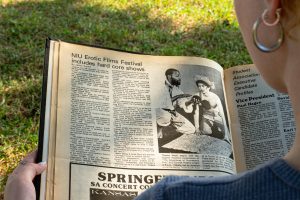NIU prof. works on DZero project
October 21, 2002
NIU physics professor Steve Martin is an expert on a controversial theory in the world of particle physics – Super Symmetry.
“Super Symmetry is a theoretical idea, which we are trying to verify experimentally,” Martin said. “The basic idea is that for every known type of subatomic particle, there is another undiscovered ‘super’ particle.”
For example, two known particles are photons and electrons. Photons are particles of light, and electrons are negatively charged particles. It already has been proven that they exist.
According to the theory of Super Symmetry, there are undiscovered “super” particles, or “sparticles,” that coincide with each of those known particles. The sparticle that coincides with the photon is called the photino, and the s-particle that coincides with the electron is called the selectron.
“It turns out that there are something like 32 types of particles that we think are out there,” Martin said.
Scientists believe they can predict a lot about the properties of these new super particles (except for their mass), because theoretically they should behave a lot like the known particles that they coincide with, Martin said.
Martin wrote a primer on the subject of Super Symmetry for graduate students and others who have studied the Standard Model. The Standard Model is a theory that describes all of the known particles.
“Even though it’s a rather complex subject, he was able to put together this basic primer so people who were reading about it for the first time were pleased with it,” physics chair John Shaffer said.
However, Martin recommends that anyone who reads his primer first should understand the Standard Model theory.
“It tends to be a kind of highly mathematical subject,” he said.
Martin currently works in a theory group at Fermi National Accelerator Laboratory (Fermilab) near Batavia. The group thinks about theories such as Super Symmetry, and then comes up with experiments that could be done to prove or disprove the theories.
One of the experiments being done at Fermilab is called DZero, which uses a large machine called the Tevatron. Physics professor Gerald Blazey, who is a co-spokesman for the DZero experiment, said the Tevatron could be used to discover Super Symmetry. Super particles could be detected by colliding other particles together using the Tevatron. When two particles collide, there is a chance they will create one of the super particles.
Super particles are hard to detect because they’re very heavy and don’t live very long. They quickly decay into other particles, so scientists would not be able to see the super particles themselves. However, they could detect the super particles by noticing very specific patterns of what they decay into.
One reason the theory of Super Symmetry is thought to be correct is because there are two numbers used in the Standard Model Theory that are very close to each other, Martin said. According to the Standard Model theory, this would be a coincidence.
“By very close, I mean one part in a billion,” Martin said.
Super Symmetry, if it’s true, would clarify why these numbers are so close.






